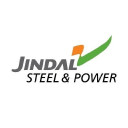FMP

Jindal Steel & Power Limited
JINDALSTEL.NS
NSE
Jindal Steel & Power Limited operates in the steel, power, mining, and infrastructure sectors in India and internationally. It operates through Iron and Steel Products, Power, and Others segments. The company offers track and crane rails, and flash-butt welded rail panels; and medium and heavy hot rolled parallel flange beams and column sections for use in refineries, metro rail projects, airports, flyovers, power plants, highways, malls, and high rise buildings. It also provides discrete and cut to length plates, and hot rolled coils that are used in general engineering and structural fabrication, railway wagons, pressure vessels and boilers, oil and gas pipelines, bridges and flyovers, shipbuilding, earthmoving equipment, wind mills, and defense equipment; angles and channels for infrastructure, and industrial and light construction segments; TMT rebars; wire rods for various applications; round bars; and fabricated sections. In addition, the company offers suspended concrete flooring systems for use in steel frame structures, RCC frame buildings, poured insitu or precast concrete frames, light gauge steel frames, and conventional structural brick wall constructions; semi-finished products for pipe industries, integrated mills, and rolling facilities; and coal-based sponge iron products. Further, it operates coal and iron ore mines located at various locations in India and internationally; a 3400 MW thermal power plant in Tamnar, Chhattisgarh; and a 258 KM long 400 KV double circuit transmission line to pump the power into the National Grid in India. Additionally, the company produces cement under the Jindal Panther brand; and provides structural steel fabrication and project management services for constructing steel buildings, as well as offers engineering based customized construction solutions. The company was incorporated in 1979 and is based in New Delhi, India.
909.55 INR
8.05 (0.885%)
Operating Data
Year
2019
2020
2021
2022
2023
2024
2025
2026
2027
2028
Revenue
442.93B
489.04B
696.47B
527.11B
500.27B
529.55B
560.55B
593.37B
628.1B
664.87B
Revenue %
-
10.41
42.41
-24.32
-5.09
5.85
5.85
5.85
5.85
Ebitda
67.87B
134.97B
152.65B
87.7B
103.57B
108.22B
114.56B
121.26B
128.36B
135.87B
Ebitda %
15.32
27.6
21.92
16.64
20.7
20.44
20.44
20.44
20.44
Ebit
33.59B
110.83B
131.68B
60.79B
75.36B
80.22B
84.92B
89.89B
95.15B
100.72B
Ebit %
7.58
22.66
18.91
11.53
15.06
15.15
15.15
15.15
15.15
Depreciation
34.29B
24.14B
20.97B
26.91B
28.22B
28B
29.64B
31.37B
33.21B
35.15B
Depreciation %
7.74
4.94
3.01
5.11
5.64
5.29
5.29
5.29
5.29
EBIT (Operating profit)(Operating income)(Operating earning) = GROSS MARGIN (REVENUE - COGS) - OPERATING EXPENSES (R&D, RENT) EBIT = (1*) (2*) -> operating process (leverage -> interest -> EBT -> tax -> net Income) EBITDA = GROSS MARGIN (REVENUE - COGS) - OPERATING EXPENSES (R&D, RENT) + Depreciation + amortization EBITA = (1*) (2*) (3*) (4*) company's CURRENT operating profitability (i.e., how much profit it makes with its present assets and its operations on the products it produces and sells, as well as providing a proxy for cash flow) -> performance of a company (1*) discounting the effects of interest payments from different forms of financing (by ignoring interest payments), (2*) political jurisdictions (by ignoring tax), collections of assets (by ignoring depreciation of assets), and different takeover histories (by ignoring amortization often stemming from goodwill) (3*) collections of assets (by ignoring depreciation of assets) (4*) different takeover histories (by ignoring amortization often stemming from goodwill)